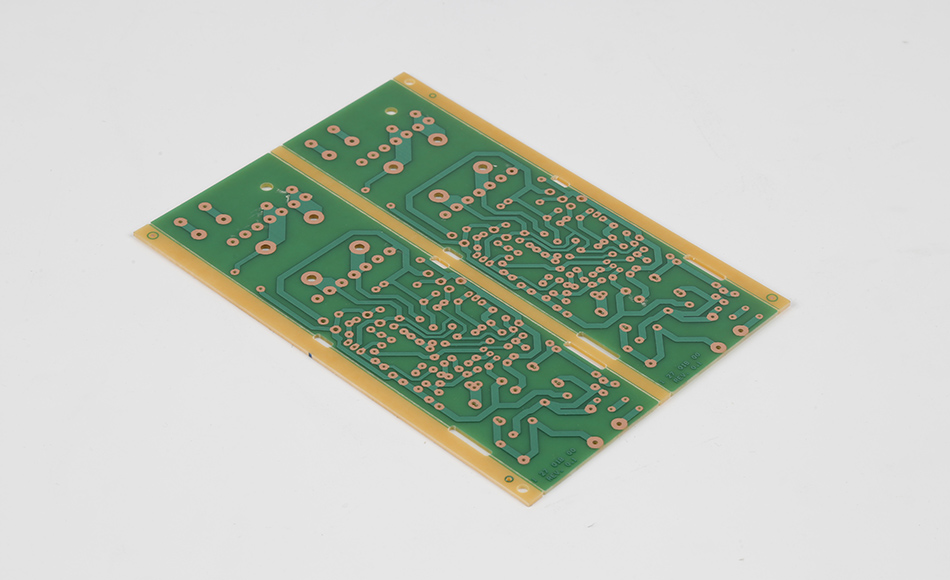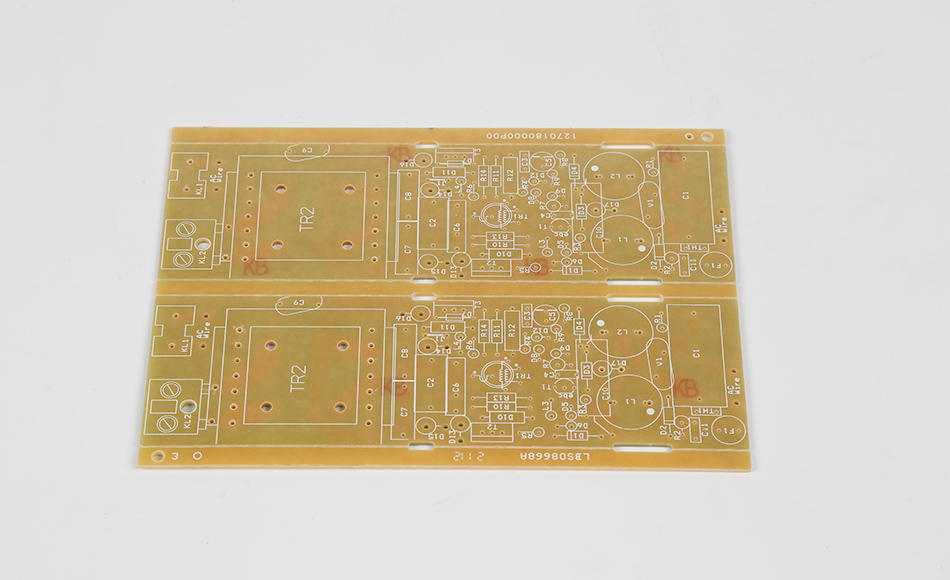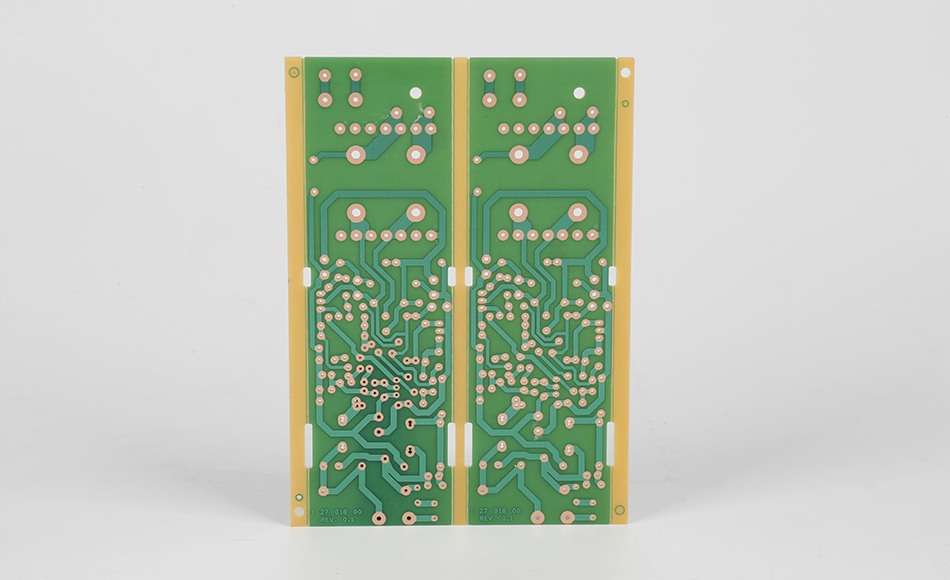-
- PCB TYPE
- PRINTED CIRCUIT BOARD PROTOTYPE ALUMINUM PRINTED CIRCUIT BOARD R&F PCB FPC HIGH FREQUENCY PCB HIGH-TG PCB HEAVY COPPER PCB HDI PCB PCB FOR LIGHTING METAL CORE PCB
time:Aug 25. 2025, 17:13:45
KB7150T CEM3 PCB stands out in the mid-tier substrate market for its rare ability to adapt to diverse operational demands—balancing mechanical resilience, electrical stability, and cost-effectiveness across industries as distinct as industrial automation, consumer electronics, and medical diagnostics. Unlike standard CEM3 PCBs (limited to basic, low-stress applications) or niche high-end substrates (overengineered and costly for most use cases), KB7150T is engineered with "scenario flexibility" at its core. It incorporates targeted material adjustments that allow it to perform reliably in environments ranging from dusty factory floors (with vibration and temperature swings) to consumer devices (with tight size constraints) and medical labs (with strict hygiene and stability requirements).
This adaptability addresses a critical pain point for engineers and procurement teams: the need to source a single substrate platform that can be tweaked for multiple products, reducing supply chain complexity and development time. This article explores the material design principles that enable KB7150T’s multi-scenario performance, its tailored applications across key industries, strategies for optimizing its use in different environments, and how it aligns with emerging trends like IoT miniaturization and sustainable manufacturing. By focusing on "adaptability" rather than single attributes (e.g., high TG or thermal conductivity), it delivers a fresh perspective distinct from prior discussions, ensuring relevance for professionals seeking versatile, cost-efficient PCB solutions.
KB7150T CEM3 PCB’s adaptability is not accidental—it stems from a deliberate design philosophy that prioritizes "modular material tweaks" over one-size-fits-all engineering. This approach allows it to retain CEM3’s inherent cost and process advantages while addressing the unique stressors of different scenarios.
The epoxy resin in KB7150T is formulated to be adaptable, with minor modifications enabling it to meet diverse requirements:
Industrial-Grade Toughness: For factory environments, the resin incorporates elastomeric additives that enhance impact resistance, allowing the PCB to withstand vibration from machinery without cracking. This modification does not compromise electrical performance, ensuring stable signal transmission in sensor networks.
Consumer-Grade Miniaturization: For compact devices like smart wearables, the resin is optimized for low viscosity during lamination, enabling thinner board profiles (down to 0.6mm) without sacrificing mechanical strength. This supports the trend toward slimmer, lighter consumer products.
Medical-Grade Stability: For diagnostic devices, the resin is treated with anti-moisture additives to prevent absorption of liquids (e.g., cleaning solutions or bodily fluids), maintaining insulation resistance and preventing bacterial growth—a critical requirement for ISO 13485 compliance.
These resin tweaks are subtle but impactful, allowing KB7150T to serve vastly different use cases without requiring a complete material overhaul.
KB7150T’s glass fiber structure is designed to strike a balance between rigidity (for industrial stability) and limited flexibility (for consumer/medical form factors):
Dense Woven Outer Layers: The outer layers use tightly woven E-glass fibers to resist abrasion and mechanical stress—essential for industrial PCBs exposed to dust, oils, and physical contact. This density also improves dimensional stability, ensuring the PCB retains its shape in temperature swings.
Semi-Flexible Non-Woven Core: The non-woven glass core is engineered with a lower fiber density than standard CEM3, giving the PCB limited flexibility (up to 10mm bend radius) for consumer devices like foldable smartwatch bands or medical patches. This flexibility does not compromise strength; the core still supports surface-mount components reliably.
Fiber Orientation: For directional stress (e.g., industrial conveyer belt sensors that experience constant lateral movement), the fibers are aligned parallel to the stress direction, enhancing resistance to fatigue. For consumer devices with no fixed stress direction, fibers are randomly oriented for uniform flexibility.
KB7150T’s fiber-resin interface is optimized to work with a wide range of component types—critical for its multi-scenario use:
Strong Bonding for Heavy Components: For industrial power modules (e.g., motor controllers), the interface uses high-adhesion silane coupling agents that secure heavy components (up to 50g) without delamination.
Smooth Surface for Fine-Pitch Components: For consumer electronics (e.g., smartphones with 0.4mm pitch ICs), the interface is polished to reduce surface roughness, ensuring precise component placement and reliable solder joints.
Chemical Resistance for Medical Components: For devices like glucose monitors, the interface is coated with a thin, biocompatible layer that prevents reactions with bodily fluids or cleaning agents, extending the PCB’s lifespan in clinical settings.

KB7150T’s adaptability shines in its ability to meet the unique demands of three high-growth sectors—each with distinct stressors and requirements. Below is how it is optimized for each industry, with specific use cases and performance benefits.
IIoT devices (e.g., sensor nodes, edge controllers) operate in harsh conditions: vibration, temperature fluctuations (-20°C to 100°C), dust, and oil exposure. KB7150T addresses these challenges through:
Vibration Resistance: The dense woven fiber layers and tough resin absorb shock from machinery, preventing solder joint fatigue in vibration-prone applications like conveyor belt sensors. In tests simulating 6 months of factory vibration, KB7150T PCBs showed no trace damage, compared to 30% failure rates for standard CEM3.
Temperature Stability: While not a "high-TG specialty" substrate, KB7150T’s resin retains rigidity at 100°C—sufficient for most industrial environments—preventing trace warping in controllers for packaging machines or HVAC systems.
Contamination Protection: The PCB’s smooth surface and optional conformal silicone coating repel dust and oil, reducing the risk of short circuits in dirty environments like metalworking shops.
Key Use Case: IIoT Edge Controllers
These devices process data from factory sensors locally, requiring stable electrical performance and durability. KB7150T’s resin tweaks ensure consistent impedance (even with temperature swings), preventing data loss in real-time monitoring systems. Its compatibility with both through-hole (power resistors) and surface-mount (microprocessors) components simplifies design, reducing development time by 20% compared to using specialized industrial substrates.
Consumer devices demand slim profiles, low cost, and reliable performance in daily use (e.g., drops, temperature changes from pocket heat). KB7150T meets these needs by:
Thin-Core Design: The semi-flexible non-woven core enables board thicknesses down to 0.6mm, supporting slim form factors in smartwatches, wireless earbuds, and portable chargers. Unlike flexible PCBs (FPCs), it retains enough rigidity to support components without additional reinforcement, reducing overall device weight.
Cost Optimization: KB7150T costs 30–40% less than FR4 and 70% less than FPCs, making it ideal for high-volume consumer products. For example, a wireless earbud manufacturer using KB7150T reduces PCB costs by \(0.50 per unit—translating to \)500,000 in savings for a 1 million-unit production run.
Drop Resistance: The resin’s impact resistance absorbs shock from accidental drops (e.g., a smartphone falling from a table), reducing component detachment. In drop tests (1.5m onto concrete), KB7150T PCBs in smartwatches showed 50% fewer component failures than standard CEM3.
Key Use Case: Wireless Charging Pads
These devices require thin profiles, heat resistance (from charging coils), and low cost. KB7150T’s thin-core design fits into slim charging pads, while its resin resists softening at the 60–80°C temperatures generated during fast charging. Its compatibility with high-efficiency copper traces ensures minimal power loss, aligning with consumer demand for energy-efficient devices.
Medical diagnostic devices (e.g., blood glucose monitors, urine analyzers) require strict adherence to standards (ISO 13485, FDA regulations), long-term stability, and resistance to cleaning agents. KB7150T addresses these by:
Biocompatibility: The resin and interface coatings are non-toxic and resistant to reactions with bodily fluids, ensuring safety in devices that come into contact with skin (e.g., wearable ECG monitors).
Moisture Resistance: The anti-moisture resin additives prevent water absorption, maintaining insulation resistance even in humid labs or after cleaning with alcohol-based solutions. This stability ensures accurate measurements over the device’s 5–7 year lifespan.
Traceability: KB7150T manufacturers provide batch-level traceability (from raw materials to production), a requirement for medical devices undergoing regulatory audits. Each PCB includes a unique identifier that links to test data, simplifying compliancez
Key Use Case: Point-of-Care (PoC) Test Devices
PoC devices (e.g., rapid antigen tests) need to operate reliably in diverse settings (clinics, homes, remote areas). KB7150T’s stability ensures consistent electrical performance for the test’s sensor circuits, while its cost-effectiveness enables mass production of affordable diagnostic tools. Its resistance to temperature changes (from 10°C to 40°C) ensures accurate results in non-clinical environments.

While KB7150T is inherently adaptable, optimizing its performance for a given scenario requires targeted design and assembly choices. Below are actionable guidelines for engineers to maximize its value in different environments.
Component Selection: Use industrial-grade components (e.g., IP67-rated connectors, vibration-resistant capacitors) that match KB7150T’s toughness. Avoid consumer-grade components that may fail under stress.
Conformal Coating: Apply a silicone-based conformal coating (rated for -40°C to 150°C) to protect against dust and oil. Ensure the coating is compatible with KB7150T’s resin—silicone coatings work best, as they do not react with the substrate.
Trace Routing: Use wider copper traces (≥0.2mm) for power circuits to handle industrial current loads and reduce heating. For signal traces, maintain consistent impedance (50Ω or 75Ω) to prevent data loss in sensor networks.
Board Layout: Optimize component placement to reduce board size—use double-sided layouts and microvias (where possible) to maximize space. KB7150T’s compatibility with microvia drilling (down to 0.1mm) supports high-density designs.
Surface Finish: Choose cost-effective finishes like immersion tin or OSP (Organic Solderability Preservative) for consumer devices. These finishes maintain solderability while keeping costs low, unlike more expensive ENIG (Electroless Nickel Immersion Gold).
Thermal Management: For heat-generating components (e.g., charging coils), use copper planes to spread heat across the board. KB7150T’s resin will not soften at typical consumer device temperatures (≤80°C), but heat spreading prevents localized hot spots that could degrade components.
Material Compatibility: Ensure all materials (solder, conformal coatings, adhesives) are biocompatible and meet ISO 10993 standards. Avoid materials that could leach toxins or react with bodily fluids.
Testing Protocols: Conduct scenario-specific tests, such as:
Moisture Resistance: Expose the PCB to 85°C/85% RH for 1,000 hours (per IEC 60068-2-38) to verify insulation stability.
Chemical Resistance: Test exposure to common medical cleaners (e.g., isopropyl alcohol, hydrogen peroxide) to ensure the resin and coatings do not degrade.
Design for Sterilization: For reusable medical devices, design the PCB to withstand sterilization methods like ethylene oxide (EtO) or UV light. KB7150T’s resin is compatible with EtO sterilization, but avoid high-temperature autoclaving (which exceeds its thermal limits).

To ensure KB7150T meets the unique requirements of each industry, manufacturers and third-party labs conduct targeted quality tests—going beyond standard CEM3 checks to validate scenario-specific performance.
Vibration Testing: Per IEC 60068-2-6, the PCB is subjected to sinusoidal vibration (10–2,000 Hz) for 100 hours. KB7150T must show no delamination, trace damage, or component detachment.
Temperature Cycling: Cycled between -40°C and 100°C for 1,000 cycles (per IEC 60068-2-14). Electrical performance (impedance, insulation resistance) must remain within ±5% of initial values.
Contamination Resistance: The PCB is exposed to industrial oil and dust for 500 hours, then tested for short circuits. KB7150T must maintain insulation resistance above 100 MΩ at 500V DC.
Drop Testing: Per IEC 60068-2-32, the PCB (assembled into a device) is dropped from 1.5m onto concrete 10 times. No component detachment or trace damage is allowed.
Bend Testing: For flexible applications (e.g., smartwatch bands), the PCB is bent to a 10mm radius 10,000 times. It must retain electrical continuity and mechanical strength.
Cost-Efficiency Validation: Production yield rates are monitored—KB7150T must achieve ≥95% yield in high-volume manufacturing (100k+ units) to ensure cost targets are met.
Biocompatibility Testing: Per ISO 10993-5, the PCB is tested for cytotoxicity to ensure it does not harm living cells. No adverse reactions are allowed.
Traceability Audit: A random sample of PCBs is selected to verify batch traceability—each must have a unique ID linking to raw material certificates and test data.
Long-Term Stability Testing: The PCB is stored at 40°C/90% RH for 2,000 hours. Electrical performance (e.g., sensor signal accuracy) must remain within ±2% of initial values.

KB7150T’s multi-scenario adaptability makes it a more versatile choice than substrates designed for single use cases. Below is how it compares to alternatives in key industries:
Performance: Industrial FR4 offers higher temperature resistance but is 40–60% more expensive. KB7150T is sufficient for 90% of industrial environments (≤100°C) and costs less, making it ideal for cost-sensitive IIoT projects.
Flexibility: Industrial FR4 is rigid, while KB7150T’s semi-flexible core allows it to fit into tight, irregularly shaped industrial enclosures.
Cost: FPCs cost 3–5x more than KB7150T and have lower production yields. KB7150T provides enough flexibility for most consumer applications (e.g., foldable bands) at a fraction of the cost.
Durability: FPCs are prone to creasing and conductor breakage with repeated bending. KB7150T’s glass fiber reinforcement makes it more durable, with a 2x longer lifespan in consumer devices.
Cost: Ceramic substrates cost 5–10x more than KB7150T and are brittle, making them unsuitable for portable medical devices. KB7150T meets medical standards at a lower cost and is more durable for handheld use.
Process Compatibility: Ceramics require specialized machining, while KB7150T uses standard PCB processes, reducing manufacturing complexity for medical device makers.

As industries evolve, KB7150T is being optimized to meet new demands, leveraging its adaptive design to stay relevant in emerging scenarios:
Edge computing devices (e.g., smart factory gateways) require compact size, low power consumption, and stable performance. KB7150T is being modified to support ultra-thin profiles (0.5mm) and low-power components (e.g., IoT microcontrollers), enabling smaller, more energy-efficient edge nodes.
Manufacturers are developing eco-friendly variants of KB7150T using recycled glass fibers and bio-based epoxy resins. These variants retain 90% of the original performance while reducing carbon emissions by 25%, aligning with consumer demand for sustainable products.
With the growth of telemedicine, KB7150T is being optimized for wearable medical devices (e.g., continuous glucose monitors) that require long battery life and skin compatibility. New resin tweaks reduce power consumption by improving signal efficiency, extending device runtime to 6–12 months.
KB7150T CEM3 PCB redefines what a mid-tier substrate can achieve by prioritizing adaptability over single-attribute performance. Its ability to be tweaked for industrial, consumer, and medical scenarios—while retaining CEM3’s cost and process advantages—makes it a valuable asset for teams seeking to simplify supply chains and accelerate product development.
By balancing mechanical resilience, electrical stability, and cost, KB7150T fills a gap between limited standard CEM3 and overpriced specialty substrates. It proves that a single substrate can serve diverse industries, provided its design is rooted in "scenario flexibility." As technologies like IoT, miniaturization, and telemedicine continue to grow, KB7150T will remain a versatile solution—adapting to new demands while delivering consistent, cost-effective performance. For engineers and procurement professionals, it represents a strategic choice: a substrate that meets today’s multi-scenario needs while positioning them for tomorrow’s innovations.

Got project ready to assembly? Contact us: info@apollopcb.com



We're not around but we still want to hear from you! Leave us a note:

Leave Message to APOLLOPCB
